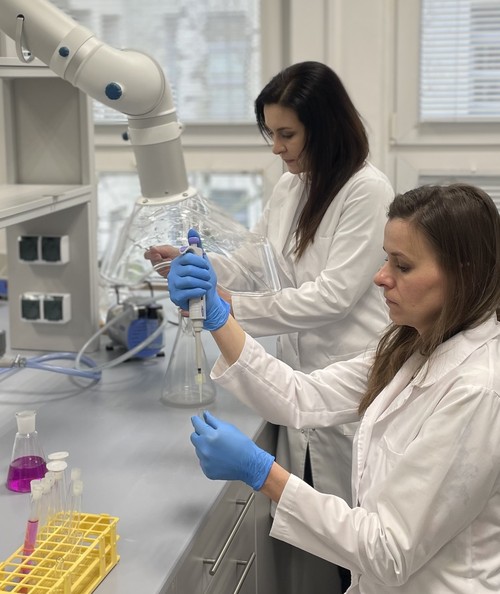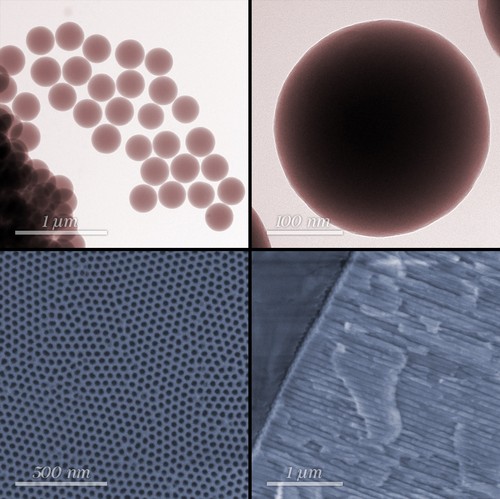Tireless microbial killers in new nanocomposites
8 March 2023
EurekAlert!: [https://www.eurekalert.org/news-releases/982223]

In the laboratories of the Institute of Nuclear Physics of the Polish Academy of Sciences, nanocomposites capable of continuous destruction of microorganisms have been produced. (Source: IFJ PAN)
They kill with a molecular sting or oxidative shock and don’t know the meaning of fatigue. The latest biocidal nanocomposites, designed and synthesised by scientists at the Institute of Nuclear Physics of the Polish Academy of Sciences (IPJ PAN) in Cracow, are charting new directions for materials engineering in the fight against microorganisms.
The increasing number of antibiotic-resistant bacteria is posing challenges not only to physicians, but also to physicists involved in materials engineering. In mankind's generations-long Sisyphean struggle against the world of dangerous microorganisms, it seems that we have finally gained allies ready to meet the challenge: composite materials capable of spontaneously and continuously killing microorganisms and preventing their colonies from growing. The biocidal nanocomposites, designed, synthesised and characterised at the Institute of Nuclear Physics of the Polish Academy of Sciences (IFJ PAN) in Cracow, Poland, are discussed in a series of recently published scientific articles.
“In the work of our team, we try to apply the idea of 'reverse physics': we start not with the substance
we want to study to find applications for it, but with the applications themselves. Once we have
established our needs, we design the future material precisely with these needs in mind, carry out
numerical simulations, and then try to synthesise it. Only when we manage this successfully, do
we proceed to check whether the properties of the obtained material are in line with our expectations
”,
explains Dr. Lukasz Laskowski (IFJ PAN), leader of a team which included Dr. Agnieszka
Karczmarska, Dr. Magdalena Laskowska and Dr. Mateusz Schabikowski.
The need to develop a new, durable and safe biocidal material was signalled by researchers from the Institute of Physiology and Animal Nutrition of the Polish Academy of Sciences (IFiZZ PAN) in Jablonna. They pointed out that if the face masks known to everyone from the time of the pandemic are changed infrequently, they accumulate microorganisms and, as their habitat, can be a source of secondary infection. What would therefore be needed is a material that not only acts as a filter, but is also capable of continuously eliminating the microorganisms that settle on it. The physicists at the IFJ PAN thought that a composite material constructed from a neutral matrix with appropriately attached functional groups capable of effectively killing microorganisms could be a way to solve the problem. The permanent attachment of biocidal molecules and appropriate selection of their properties would guarantee that the material would retain its characteristics for practically any period of time.
In the case of biocidal composites with silver ions, developed by scientists from the IFJ PAN, either aluminium oxide or silicon dioxide (i.e. silica) matrices can be used, depending on the need. In the former case, the matrices are in the form of a sieve with pore diameters of about 40 nanometres, while in the latter, they are spheres with diameters ranging from 50 to 500 nm. The porous matrix makes it possible to filter, for example, air or body fluids, while the spherical silica makes it possible to incorporate the biocidal material into other substances, such as dental fillings.
“Naturally, the main role in our materials is not played by the matrix, but by the functional groups
deposited on it in an appropriate manner. The key biocidal agent, in this case the silver ion, is captured by a carboxyl group attached to a propyl chain. This structure is pliant and acts superbly as
a sting or knife, which, on contact with the bacterium, destroys its cell membrane”
, explains Dr. Laskowski.
The biocidal molecules in the new composites are bound to the matrix chemically and therefore permanently. This fact means, first and foremost, that these molecules will be able to perform their task continuously and exactly where they are placed. Over time, therefore, they will not lose their capabilities, they will not be washed out of a dental filling into the body, nor will they be released from a used mask into the environment.
The second class of new nanocomposites from the IFJ PAN uses a different tool to fight bacteria: propyl-phosphate groups containing a copper ion. They capture oxygen molecules from the air, which are then reduced by the copper ion, acting as a single-electron catalyst. The reactions taking place involve hydrogen from the water molecules common in our environment. As a result, hydrogen peroxide is continually formed around the copper functional groups. On contact with it, most microorganisms are killed by oxidative shock.
“As with silver nanocomposites, the copper is also permanently bonded to the matrix and does not
wear out. Water and oxygen are consumed, but these are naturally available in the environment.
Thus, we have a material at our disposal which practically continuously produces a certain amount
of fresh hydrogen peroxide, one of the most effective biocidal compounds
”, says Dr. Laskowski and
emphasises that tests verifying the biocidal effects of all new materials have been carried out at the
IFiZZ PAS.
Bioactive nanocomposites with metal ions are currently being produced at IFJ PAN on a laboratory scale, with the possibility of supplying trial quantities for implementation purposes. However, the production technology, which is at the patent stage, can be scaled up to industrial needs without major problems.
The research discussed here was funded by a grant from the Polish National Science Centre.
[PDF]
Contact:
Dr. Łukasz Laskowski
Institute of Nuclear Physics, Polish Academy of Sciences
tel.: +48 12 662 82 17, +48 12 662 82 63
email: lukasz.laskowski@ifj.edu.pl
Scientific papers:
“Aluminium(III) Oxide - The Silent Killer of Bacteria”
M. Schabikowski, P. Kowalczyk, A. Karczmarska, B. Gawdzik, A. Wypych, K. Kramkowski, K. Wrzosek, Ł. Laskowski;
Molecules 2023 Jan 3;28(1):401;
DOI: https://doi.org/10.3390/molecules28010401
“A Novel Biocidal Nanocomposite: Spherical Silica with Silver Ions Anchored at the Surface”
M. Laskowska, P. Kowalczyk, A. Karczmarska, K. Kramkowski, K. Wrzosek, Ł. Laskowski;
International Journal of Molecular Sciences 24(1), 545, 2023;
DOI: https://doi.org/10.3390/ijms24010545
“Functionalised Anodised Aluminium Oxide as a Biocidal Agent”
M. Schabikowski, M. Laskowska, P. Kowalczyk, A. Fedorchuk, E. Szőri-Dorogházi, Z. Németh, D. Kuźma, B. Gawdzik, A. Wypych, K. Kramkowski, Ł. Laskowski;
International Journal of Molecular Sciences 23(15), 8327, 2022;
DOI: https://doi.org/10.3390/ijms23158327

